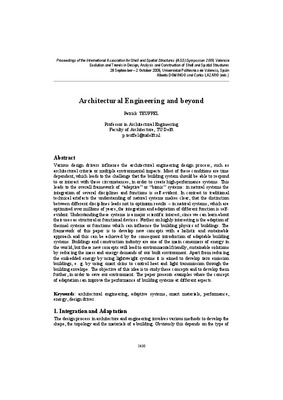|
Resumen:
|
Various design drivers influence the architectural engineering design process, such as
architectural criteria or multiple environmental impacts. Most of these conditions are time
dependent, which leads to the challenge ...[+]
Various design drivers influence the architectural engineering design process, such as
architectural criteria or multiple environmental impacts. Most of these conditions are time
dependent, which leads to the challenge that the building system should be able to respond to or interact with these circumstances, in order to create high-performance systems. This leads to the overall framework of "adaptive" or "bionic" systems: in natural systems the integration of several disciplines and functions is self-evident. In contrast to traditional technical artefacts the understanding of natural systems makes clear, that the distinction between different disciplines leads not to optimum results - in natural systems, which are optimized over millions of years, the integration and adaptation of different function is selfevident. Understanding these systems is a major scientific interest, since we can learn about their uses as structural or functional devices. Further on highly interesting is the adaption of thermal systems or functions which can influence the building physics of buildings. The framework of this paper is to develop new concepts with a holistic and sustainable approach and this can be achieved by the consequent introduction of adaptable building systems. Buildings and construction industry are one of the main consumers of energy in the world, but these new concepts will lead to environmental friendly, sustainable solutions by reducing the mass and energy demands of our built environment. Apart from reducing the embedded energy by using lightweight systems it is aimed to develop zero emission buildings, e. g. by using smart skins to control heat and light transmission through the building envelope. The objective of this idea is to study these concepts and to develop them further, in order to save our environment. The paper presents examples where the concept of adaptation can improve the performance of building systems at different aspects.
[-]
|







